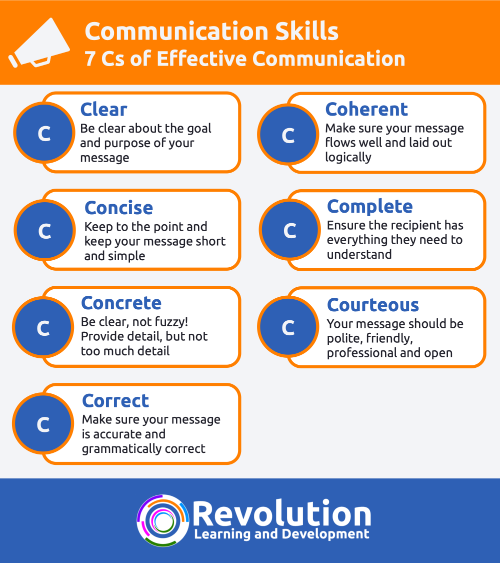Background
The 7 Cs of Communication is a checklist to ensure that your communication is effective. We communicate with people every day, both at work and in our personal life. We communicate using a number of different methods – face to face, telephone, email, instant messenger, letters, reports, meetings, presentations and more.
In order to ensure you get the right result when you communicate you need to ensure that your communication is effective and clear and this is where the 7 Cs of Communication can help.
The 7 Cs of Communication
The 7 Cs is a checklist for ensuring your emails, meetings, calls, reports, presentations and other methods you use to communicate are clear and that the recipient gets the message.

The 7 Cs of Communication are:
- Clear
- Concise
- Concrete
- Correct
- Coherent
- Complete
- Courteous
Clear
(Clarity) Be clear about the goal of your message and the purpose of the message. Present one idea at a time making it easier for the recipient to understand. Don’t leave them guessing what the message is about and having to fill in the gaps themselves.
Set a goal or outcome for what you want to communicate and work towards that.
Concise
(Conciseness) Keep to the point and keep it short and simple. Don’t use unnecessary words (use two words where one will do or 6 sentences when 3 will do). Don’t repeat the same point in different ways.
This will also make any communication more engaging and easier to understand.
Concrete
(Concreteness) Be clear, not fuzzy. Ensure there is enough detail to get the message across but not too much so that the recipient will be lost and that the message is factual.
Adding too much ‘noise’ around your main points can mean these are missed. Make sure your main points and any conclusions are clear to the recipient.
Correct
(Correctness) Check the information you are providing is accurate and, in written communication, ensure it is free from grammatical and spelling errors. Check the technical parts of your content are understandable by the person receiving the information.
Preparation will help here to make sure you can be sure about what you are communicating or a chance to read what you have written.
Coherent
Make sure your message flows well and is laid out logically. The points you make should all be linked to the main topic and should help you to deliver the objective you originally set out to achieve. Make sure the tone of the message is the same throughout.
Consider using a structure for your communication to help here.
Complete
(Completeness) Ensure the recipient has everything they need to understand your message and take action if needed. If action is needed, ensure your message includes a ‘call to action’. Also, ensure that any specific details are clear and included. Don’t leave the recipient with lots of questions to ask.
Think about how you will check for understanding. For example, you could ask questions to check their understanding.
Courteous
(Courtesy) Your message should be polite, friendly, professional, open and honest. Think about your message from the recipient’s point of view and you are empathetic towards their needs. This will help you to deliver the message in a way that’s easy to understand and buy into.
Also, communicating to or writing for the reader can make your communication more engaging.
By following the 7 Cs of communication you should find the messages you are delivering much more effective.
Communication Skills Training Courses
You can find out more about the 7 Cs of Communication and effective communication in general by attending our Communication Skills Training Course or for written communication our Business Writing Skills Training Course. See the Communication Skills training course overview here and the Business Writing Skills training course overview here.




